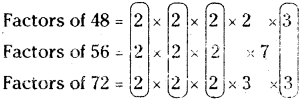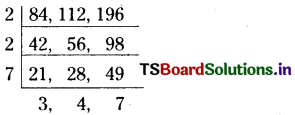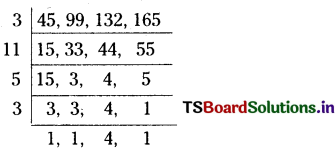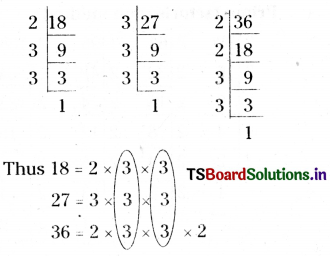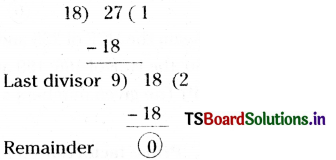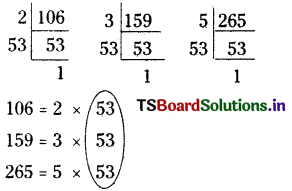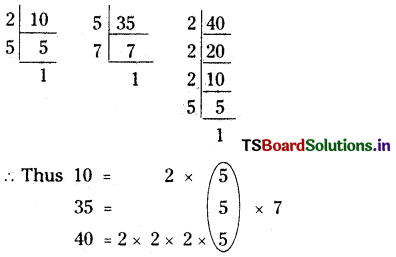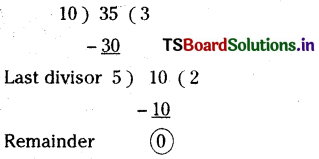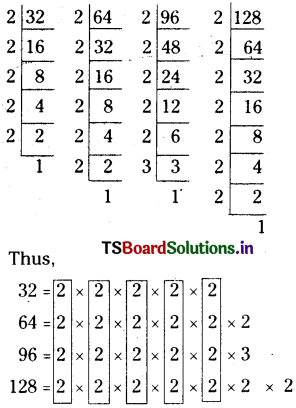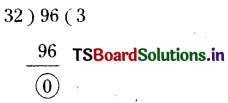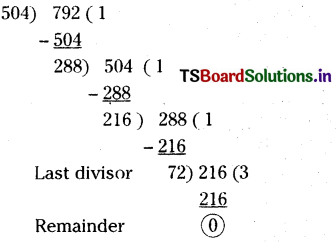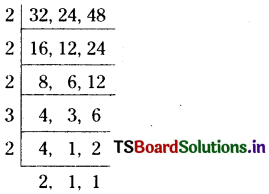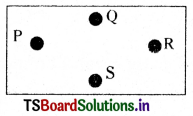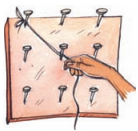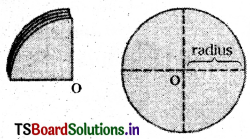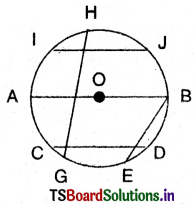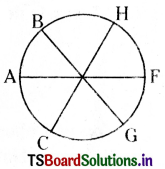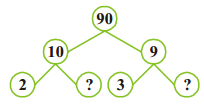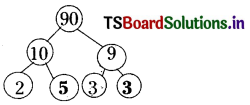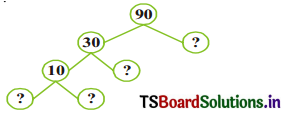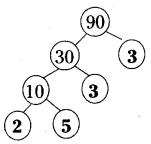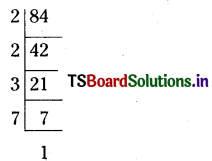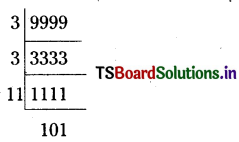Students can practice Telangana 6th Class Maths Textbook Solutions Chapter 6 Integers InText Questions to get the best methods of solving problems.
TS 6th Class Maths Solutions Chapter 6 Integers InText Questions
Do This
Question 1.
Manasa has borrowed ₹ 50 and Swetha has borrowed ₹ 20 from their mother. How will you represent this on the number line ₹ Suppose their father gave them ₹ 100 each as pocket money, who will have more money after clearing the debit ?
Answer:
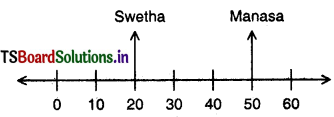
If each of them get ₹ 100 from their father
then amount at Manasa = 100 – 50 = ₹ 50
then amount at Swetha = 100 – 20 = ₹ 80
∴ Amount of Swetha is greater than that of Manasa.

Try These
Question 1.
Collect information about temperatures recorded in various places in India in the month of January and write them using integers.
Answer:
The temperatures of various places in the month of January
1. Hyderabad → 10°C
2. Siachain (J & K) → 20°C
3. Lambasingi → 5°C
Do this
Question 1.
Draw a vertical line and represent the following integers on the number line. – 5, 4, – 7, – 8, – 2, 9, 5, – 6, 2
Answer:
Vertical line :

On a number line :

![]()
Do This
Question 1.
Fill in the boxes using < or > signs.
(i) 0 ………. -1
Answer:
0 > -1
(ii) -3 ……. – 2
Answer:
-3 < -2
(iii) 5 ……… 6
Answer:
5 < 6
(iv) -4 ……… 0
Answer:
-4 < 0
Do This
Question 1.
Rajesh has a shop CM thp ground floor of a building. There are stairs going up to the terrace and stairs going down to the godown, where goods are stored.
Everyday his daughter Hasini, after coming back from school goes up to the terrace to play. She helps father in arranging things in the godown at night.
Observe the picture and try to answer the questions using integers marked on the steps.
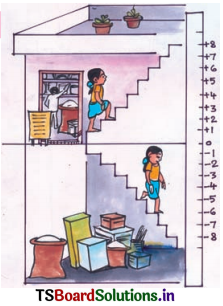
(i) Go 7 steps up from the shop.
(ii) Go 3 steps down from the ground floor.
(iii) Go 5 steps up from the ground floor and then go 3 steps further up from there.
(iv) Go 4 steps down from the ground floor and then further 3 steps from there.
(v) Go down 5 steps down from the ground floor and 10 steps up fmin there.
(vi) Go 8 steps up from the ground floor and come down 9 steps down from there.
Answer:
(i) +7
(ii) -3
(iii) 5 + 3 = + 8
(iv) (-4) + (-3) = -7
(v) (-5) + 10 = +5
(vi) (8) + (-9) = (—1)
Do This
Question 1.
Find the values of the following.
(i) -7 + 8
(ii) -3 + 5
(iii) – 3 – 2
(iv) + 7 – 10
Answer:
(i) (- 7) + (8)
= (- 7) + (+ 7) + (+1)
= [(-7) + (+7)] + (+1)
= 0 + 1 = 1
(ii) (- 3) + (+ 5)
= [(-3) + (+3)] + (+2)
= 0 + 2 = 2
(iii) (-3) +(-2)
= [-(3 + 2)] = -5
(iv) (+7) + (-10)
= (+7) + [(-7) + (-3)]
= [(+7) + (-7)] + (-3)
= 0 – 3
= – 3
![]()
Try These
Question 1.
Find the value of the following using a number line.
(i) (- 3) + 5
(ii) (- 5) + 3
Make your own two new questions and solve them using the number line.
Answer:
(i) (- 3) + 5 = (- 3) + (3 + 2) = [- 3 + 3] + 2 = 0 + 2 = 2
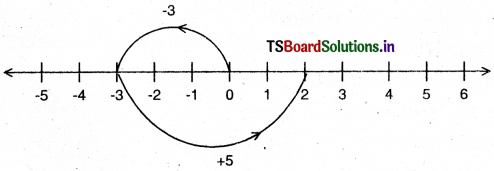
(ii) (- 5) + 3 = [(- 3) + (- 2)] + 3 = [(- 3) + 3] + (- 2) = 0 + (- 2) = – 2

Ex: (i) (-4) + 1 = -3

(ii) 6 + (-4) = 2

Question 2.
Find the solution of the following:
(i) (+5) + (-5)
(ii) (+6) + (-7)
(iii) (-8) + (+2)
Ask your Mend to give five such questions and solve them.
Answer:
(i) (+ 5) + (- 5) = 5 – 5 = 0
(ii) (+ 6) + (- 7) = (+6) + [(- 6) + (- 1)] = [(+ 6) + (-6)] + (- 1) = 0 + (- 1) = – 1
(iii) – 8 + (+ 2) = [(- 6) + (- 2)] + (+ 2) = (- 6) + [(- 2) + (+ 2)] = (- 6) + 0 = – 6
Five related problems.
(i) (-6) + (-3)
(ii) (+8) + (-5)
(iii) (-16) + 15
(iv) 10 + (-6)
(v) (+11) + (-12)
Answer:
(i) (- 6) + (- 3)
= (- 6) + (- 3)
= – 9
(ii) (+ 8) + (- 5) = [(+ 3) + (+ 5)] + (-5)
= (+ 3) + [(+ 5) + (- 5)]
= (+ 3) + 0 = 3
(iii) (- 16) + 15
= [(- 15) + (- 1)] + 15
= (- 15) + (+ 15) + (- 1)
= – 1
(iv) 10 + (- 6)
= [(+ 4) + (+ 6)] + (- 6)
= (+4) + [(+ 6) + (- 6)]
= (+ 4) + 0 = + 4
(v) (+ 11) + (- 12)
= (+ 11) + [(- 11) + (- 1)]
= [(+ 11) + (- 11)] + (- 1)
= 0 + (- 1)
= – 1
Do This
Question 1.
Find the solution of the following.
(a) -5- (-3)
(b) – 7 – (+2)
(c) – 7 – (-5)
(d) 3 – (-4)
(e) 5 – (+7)
(f) 4 – (- 2)
Sol.
(a) – 5 – (- 3) = – 5 + 3 = – 2
(b) – 7 – (+2) = – 7 – 2 = – 9
(c) – 7 – (- 5) = – 7 + 5 = – 2
(d) 3 – (- 4) = 3 + 4 = + 7
(e) 5 – (+ 7) = 5 – 7 = – 2
(f) 4 – (- 2) = 4 + 2 = + 6
![]()
Think, Discuss And Write
Question 1.
Observe that as the number we subtract from 3 is decreasing, the result obtained is increasing. Is it true for all integer’s?
3 – 3 = 0
3 – 2 = 1
3 – 1 = 2
3 – 0 = 3
3 – (-1) = 4
3 – (- 2) = 5
3 – (- 3) = 6
Answer:
No, it is not true for all the integers.
Since 3 – 4 = – 1
3 – 5 = – 2
3 – 6 = – 3 it is decreasing.




